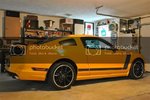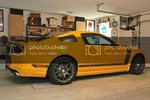- 99
- 0
Tucson302 said:Boss 738
Do you have the trans scoop installed?
Yes currently it is still installed
This site may earn a commission from merchant affiliate links, including eBay, Amazon, and others.
Tucson302 said:Boss 738
Do you have the trans scoop installed?
The scoop is pretty stout and can take several scraping with no major damage. I only know of one owner that has replaced their scoop because of damage...so far. ;DTucson302 said:Boss 738
Do you have the trans scoop installed?


Justin said:any word on the spring rates yet on these springs?
thanks!ford20 said:My bad, I missed the post. I will PM Kelly tomorrow and see if he can get me the spring rates for you. Sorry about that.
Jimmy Pribble said:Nice. I'll add a couple.
Mustang GT (2011+) Stock: Ft 122 lbs/in Rr 154 lbs/in *
Brembo Stock: Ft 131 Rr167 lbs/in
Boss Stock: Ft 148 Rr 185 lbs/in
Boss LS Stock: Ft 137 Rr 191 lbs/in
Eiback Pro-Kit: Ft 159 Rr 193 lbs/in *
M- 5300-K rate: Ft 173-248 lbs/in – Rears 195-236 lbs/in
Steeda Competition: Ft 225 Rr 185 lbs/in
Steeda Sports: Ft 200 Rr 175 lbs/in
Steeda Boss Springs Ft 225 Rr 195 lbs/in
Steeda Ultra-lite (pn 555-8206) 1.25/1.5 front: 195lb/in / rear: 175lb/in
* Sourced from Maximum Motorsports website.
Orange said:Can someone please explain why the front springs are all so much harder compared to stock than the rear springs which are sometimes even softer?
Wouldn't something like that not be a good setup: For example only taking the rear springs of the Steeda Boss package and not changing the one in the front?
Brandon302 said:It may be for the same reason that, even though Ford recommends shocks at 5 all around, I was faster with the rears softer then the front since it allowed for a little movement instead of being so stiff it slammed.
captdistraction said:Am I crazy, boro92 or do you have that backwards?
I was always under the impression Audi lowers the rears of their cars more (reverse rake) to help with the engine being past the front wheels in most of their cars.
I could be crazy though.
boro92 said:This, and also a strut front end car benefits from a higher front spring rate (proportional to the rear). Most track and race cars you'll find stiff front rates vs the rear on a Mustang. Crisper turn in, and less understeer (counter-intuitive I know). I've written about this at length in another thread.
Don't be dismayed by the higher rates though. 225lb/in front is still very mild. Some people run higher than 225lb/in in the rears alone on the track--let alone the front.
FWIW if I recall correctly, the 302s was somewhere near 500lb/in up front. Which honestly I'm not sure about that being enough in our street weight cars (302s is much lighter, so it get's away with less spring). My old track car was 300 to 400lbs lighter than the boss, and despite running 460lb/in and I could have gone stiffer (but FWIW, I didn't run a large front bar either).
What matters most is the wheel rate--not spring rate. Each end of the car has an effective motion ratio. So although the spring can be a stiffness of X lb/in, the stiffness drops down to Y lb/in where the wheel is mounted. This is due to geometry, mounting points and ultimate design of the car.
Orange said:Thanks for the different feedbacks, but why has Ford not done that already instead of selling track ready cars with such a low spring rate?
And yes, as you see I am newbie in this area. :